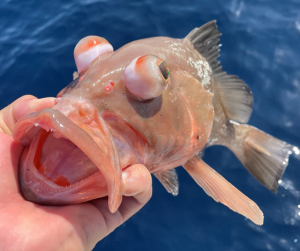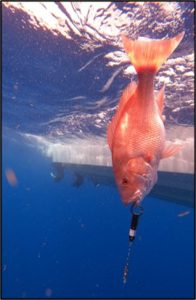
Do I need a descending tool on-board when fishing from my vessel for reef fish in Florida? The answer is YES! But the regulations are a little different depending upon where you are fishing. Atlantic Ocean federal waters (3+ nautical miles offshore) all recreational, commercial, and for-hire vessels are required to have a working descending device on-board and readily available when fishing for reef fish. This requires a dedicated pole or handline with a minimum 16-ounce weight attached to a release tool, or a weighted container, with at least 60 feet of line that is capable of returning fish back to a depth of at least 50  feet. You have two choices in Gulf of Mexico federal waters (9+ nautical miles offshore) or Florida state waters on either side of the Keys: either a descending device as described above or a venting tool must be on-board and readily available. Note that knives and ice picks are not legal venting tools and do more harm than good. Reef fishing species are the snappers, groupers, grunts, jacks, porgies, seabass, spadefish, hogfish, triggerfish, and tilefish. These are fish that live at or near the bottom.
feet. You have two choices in Gulf of Mexico federal waters (9+ nautical miles offshore) or Florida state waters on either side of the Keys: either a descending device as described above or a venting tool must be on-board and readily available. Note that knives and ice picks are not legal venting tools and do more harm than good. Reef fishing species are the snappers, groupers, grunts, jacks, porgies, seabass, spadefish, hogfish, triggerfish, and tilefish. These are fish that live at or near the bottom.
A descending tool is either a weighted device with a hook or grip that is attached to the fish lip or gill cover to return a bloated fish to at least 50 feet of water. A venting tool is a hollow needle that is inserted into the air bladder at a 45-degree angle just behind the pectoral fins. Both are effective means to release the gases trapped inside the air bladder to return living fish back to the bottom. Barotrauma in fish is similar to decompression sickness (aka “the bends”) that SCUBA divers can get if they ascend too quickly without decompressing prior to surfacing. The dissolved gases in the body come out of the blood and accumulate in organs and tissues. When a fish is reeled in from depths starting around 50 feet, the gases in the air bladder expand too quickly and may cause the stomach to protrude out of the mouth, bulging pop-eyes, and bloated or bulging intestines. Descending devices use a weight to return the fish to depth, which recompresses the expanded gas and reverses these impacts. A venting tool is inserted into the air bladder to remove the gases. While it is a legal requirement to have descending tools on-board your boat, only use these tools if the fish are showing the signs of barotrauma.

Florida Sea Grant offers free online modules and videos that explain what you need and how to use them! Return ‘Em Right is quick and easy, in less than 20 minutes on your phone or computer you can learn the legal requirements and receive a free descending device in the mail. The Florida Friendly Angler is another course that takes about an hour and a half, and you can also receive free tools that satisfy the legal requirements upon completion. Since more than 60% of fish caught by anglers are released, it is very important these fish survive to catch again when larger or in season. Fisheries research conducted in collaboration with anglers shows that using descending tools increases fish survival. Another advantage is that returning fish back to the bottom (or at least halfway back down) reduces predation. Fish struggling or floating at the surface are easy prey for birds, dolphins, barracuda, and sharks as they try to swim down to deeper water. For more information, visit and the Florida Friendly Angler online.
 4
4
